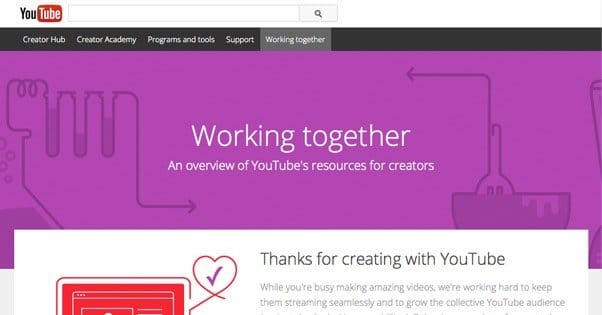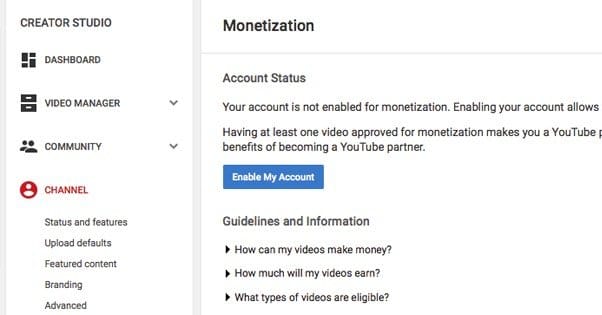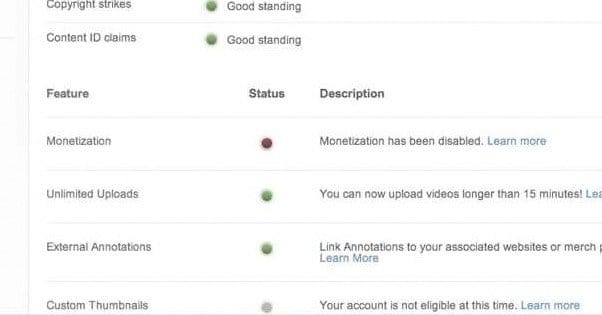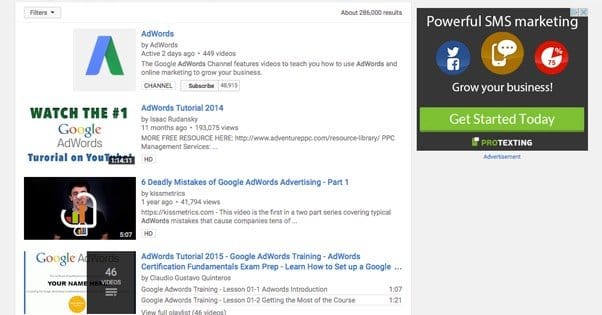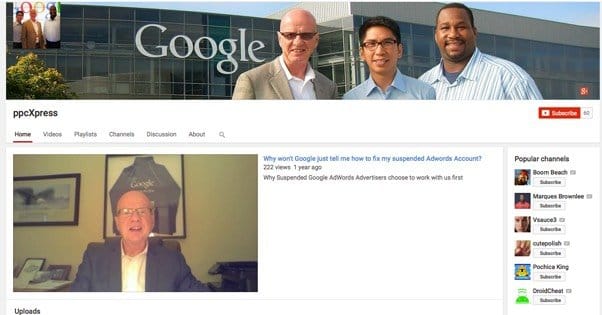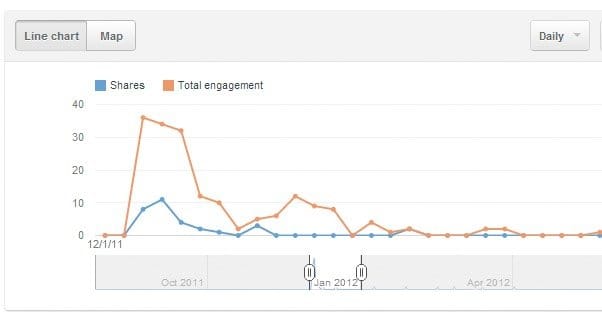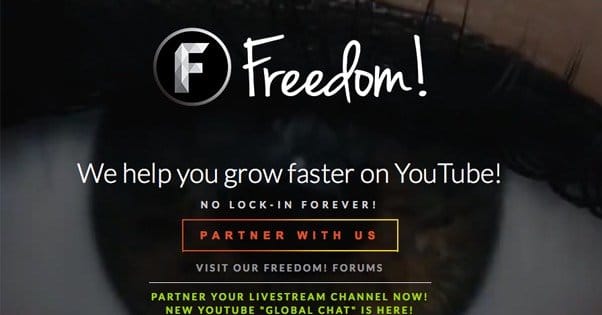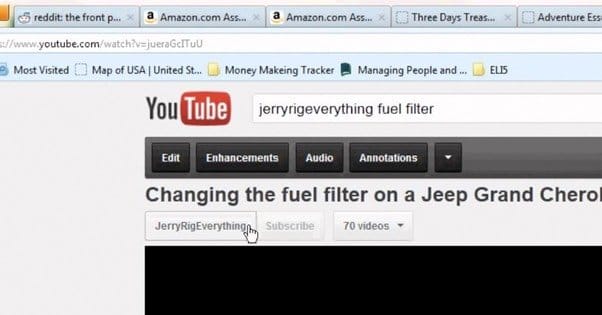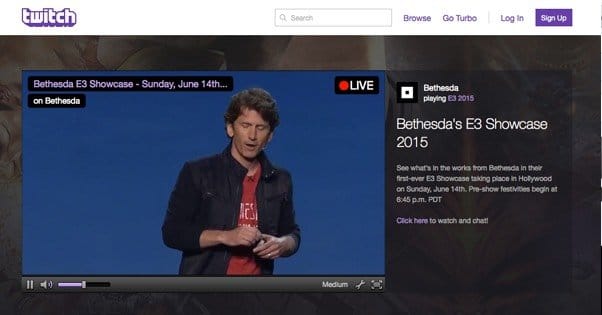 Written by ContentPowered.com
Written by ContentPowered.comYouTube has been called many things over the years. The world’s largest video repository. The second largest search engine after Google. A wretched pit of terrible comments. One thing surprisingly few people call it, though, is a great place to make money.
Have no doubt; there are people who make a living off YouTube. They are few and far between, though. Most of the accounts that make money tend to be large corporate accounts, like Vevo, which runs basically every musician’s account on the site. Did you now that Vevo is a joint venture between Google, Sony, Universal, and Abu Dhabi Media? I’ll say one thing; the last thing they need is more money.
Unfortunately, I can’t give you a solid answer about dollars and views. It’s a very finicky industry, and the numbers are changing all the time. Worse, they depend on you. It’s a personal calculation. It depends on the ads running on your channel, it depends on the partnership you signed up with and it depends on your niche.
The standard method of monetizing on YouTube comes from ads, just like anywhere else on the Internet. That’s primarily why I can’t tell you how much you’ll make at a given level of pageviews; you’re not going to be running view-based ads if you want to make any significant money. It’s the same way that ads on a blog that pay per view pay pennies per thousand views, while ads that pay per click can pay dollars per click.
Neither your subscriber count nor your video view counts matter much for your revenue from YouTube. If a video has an ad that only pays on a click, and that video receives a million views but no clicks, that video earns the creator $0.
Becoming a Partner
The first thing you need to do if you want to make money from YouTube is become a YouTube partner. This is what allows you to monetize your videos – most of them, anyways – and it’s essential if you want to run ads or be partnered with a network. There are other methods you can use to monetize, which I’ll discuss later, that don’t require being a YouTube partner. However, they don’t get you a check from Google; the money comes from another source.
In order to be eligible for monetization, you need to meet certain standards. You need to have at least one video. Your account needs to be in good standing, with no copyright strikes. You need to upload content that is advertiser-friendly. You need to comply with YouTube’s terms of service and community guidelines. You need to watch YouTube’s copyright education materials – yes, it tracks this – and you need to maintain proper standards to stay monetized. You can read more about their guidelines here. The fastest test to see if you’re able to monetize is just to try; click the monetize option in settings and see if you can enable it.
At this point, you’re able to monetize your videos on an individual basis. In order to monetize a specific video, that video has to meet certain standards as well. Your content needs to be advertiser friendly. You need to be the creator or otherwise have permission to use it commercially, complete with documentation of that fact. And, of course, you need to comply with YouTube terms, guidelines, and copyrights. From there, you just enable ads on your videos and let them run.
Disabled Monetization
There are a number of reasons why your account might be disabled for monetization. I’ll go over each of them here. You can recover from this status, generally, but it takes time and effort. You have to show YouTube that you’ve learned from past mistakes. Too many strikes, though, and you’re permanently barred from monetization.
Copyright strikes and worldwide content ID blocks disable monetization until you get them dealt with. Copyright strikes – the first ones, at least – expire after six months. This assumes that your account was otherwise in good standing.
YouTube will review a video you want to monetize before ads are applied to it. They reserve the right to reject a video for a variety of reasons. If that video is rejected, you can’t monetize it. If you repeatedly submit the same video, you may have your monetization rights in general revoked.
Invalid click activity can also bar you from monetization. This is because the ads that run on YouTube are powered by Google AdSense, and that means you’re subject to the terms and conditions of AdSense ads. Additionally, if you have an AdSense account under the same name as your YouTube account, and the AdSense account is violating a policy, it will revoke your ads access on YouTube.
Types of Ads
The ads that run on YouTube come in a number of varieties and locations, which you should expect as a marketer; it’s par for the course.
First, you have CPC ads. These are ads that pay when someone clicks on them, so long as the click is valid. The amount you get paid is the amount the advertiser pays for the ad to run, minus Google and YouTube’s cuts. These ads are typically pop-up ads at the bottom of videos.
CPV ads are the alternative, and are based on video views. Views have to meet certain criteria to count, though. The viewer needs to watch the ad for at least half of the ad or for 30 seconds, depending on which comes first. These ads typically run as videos prior to the actual YouTube video. Obviously, these ads don’t work if the viewer has an ad blocker installed. They pay a lot less than CPC ads in general, because a view is easier to get than a click.
There are also ads that run in the search results as promoted videos, and ads that run in the related videos area, but those don’t monetize your channel; they’re methods for advertisers to make money from YouTube in general.
Focusing on a Niche
As I mentioned above, the key to getting a decent payout from YouTube is engagement. You need users who click ads, and users don’t click ads if they aren’t interested in your content.
There’s another side to the story, though, and that’s the advertiser. If you’re a channel that posts anything funny you can think of, or posts your piano covers of music, or posts a daily vlog, you’re not going to attract the eyes of advertisers. Think about it from the perspective of a company like, say, Toyota. What interest do they have in running ads before the videos of a teenage girl complaining about school?
Essentially, you need to find a niche. There are two ways to go about this; carving out a niche of your own, or aggressively targeting an existing niche.
By carving out a niche of your own, what you’re doing is putting a lot of time and energy into growth so that others take notice of you. Maybe no one wanted to put ads in front of the videos of a girl playing her violin, but when she went on America’s Got Talent and became a national star, Lindsey Stirling certainly caught their attention.
The alternative is to do a lot of research before you begin producing videos. You might find out that videos about insurance attract high paying advertisers, so you set about making insurance videos. You might have a weekly feature critiquing insurance ads, you might have educational videos explaining different types of insurance, you might have how to videos explaining comparison shopping, and so forth. The point is, you have a lot of highly relevant content for companies to pay to be part of.
Getting More Engagement, Make More Videos
Once you have a niche, you need to become a YouTube success. To do this you need more videos, more viewers, and more engagement.
More videos is easy. Set up a schedule for video posting and strive to meet it. Weekly videos are good, so long as you know your audience, know your content, and have something original to produce. Originality is the key; you need to keep people interested. It doesn’t have to be much, though. Some lucrative video game streamers play the same game repeatedly for months, because the game changes each time it’s played, and every video is a new ride. A lot of their content comes from compelling commentary, of course, and that’s the tactic they need to use to succeed.
Other industries can find the same thing. Figure out what you want to do and do it. This is how you grow an audience as well; you get people interested in what you have to say, and you keep them coming back when you say more of it.
Engagement is the tricky part. Entire guides have been written about the subject. The short version is simply that you need to give them something to talk about and encourage discussion.
Partnership Networks
There’s one aspect I haven’t yet covered, but will probably come up once you reach a certain level of success; networks. There are dozens of YouTube partner networks out there, ranging from scam-level to very useful and lucrative.
A partner network is essentially a middleman. They have a multi-channel account and they get other content producers to join with their account. They monetize the content being put on those channels, but they don’t produce the content themselves. They take a cut of the cash you pull in with your content.
In exchange for this cut, they offer a number of benefits, which vary from network to network. They might give you access to royalty-free music to use in your videos without risking a copyright strike. They might help promote your videos, through their own ads and through other partner channels. They might give you access to advice, coaching, and professional-level tools for video production and audio mastering. Some might even have product sponsorships and can hook you up with equipment.
Networks can be very useful, but you need to be very, very careful before you sign on with one. Some networks rely on unsolicited messages to prey on YouTubers who don’t know any better. They hook you in on a 1, 2, even 3 year contract and take a massive cut of any profits you make, while simultaneously giving you little if any support. Always investigate a network before you sign on.
Alternative Monetization: Sponsors
Now let’s discuss some of those alternative means of monetizing your channel that I mentioned way back in the beginning of this post. This method – and the others that follow – don’t depend on being a YouTube partner. They do, however, depend on successfully engaging with your viewers.
This method, for example, is sponsorships. When you have a large enough following, it’s possible that a related brand will be willing to pay you for in-video product placement or mentions. I’ve seen tech channels that are known for reviewing hardware get paid to review specific new pieces of hardware. A food review channel might be sent samples and a check.
This is one of the more long-shot style monetization options, unfortunately. This is because there’s not a lot in the way of tracking and ROI information that goes in to this from a company’s perspective. They can send you a product to review, and money for the review, but you don’t have data about the people you send their way because of it. As such, you have to be pretty high profile to succeed with a sponsorship.
Alternative Monetization: Products
This is the most common strategy for channels run by businesses of any sort. If you have something to sell, you can sell it through a video. You can showcase your products or software in a video, you can lay on the marketing language, and you can do everything you need to for drumming up interest. New product launches, competitor reviews, comparisons, tutorials; it’s all value. You can sell with links in annotations, in descriptions, and in the video itself.
What if you’re not a company that has something to sell? One option will be discussed in a moment. The other option is to create products. There are companies like Cafepress or Society6 that allow you to create a design and have that design plastered on various products, from t-shirts to mugs and iPhone cases.
What kind of products can you make? Well, that depends on your content. One of the most common avenues I see people take is the community meme. If you have a catch phrase or an iconic item focused in your videos, that makes the basis for a design you can sell. Yes, I know, that’s not very helpful. I can’t give you anything more specific.
Alternative Monetization: Patreon
Patreon is a website dedicated to helping artists and content creators earn money to support their content creation without having to commercialize. Individual people can pledge to donate X amount of money per month, in a sort of persistent Kickstarter-like fashion, and each month the content creator collects the money.
Patreon offers two methods of payment; per month and per creation. Most artists opt for per month, because creation can vary and is less reliable. Patreon also allows artists to set up donation tiers, much like Kickstarter again, with various rewards. I’ve seen digital artists offer minor commissions at certain tiers, for example.
For YouTube content creators, one good way to entice people to donate is with a paywall. You can set up a specific comment stream that only donors of a certain tier or higher have access to. You can then, say, share unlisted videos a week early for donors, with public release coming later. It’s a simple reward for people who want to give you money for the content you create when there’s no other real option.
Alternative Monetization: Affiliate Marketing
Affiliate marketing is the other option you have with selling products. You don’t have to sell your own, or create custom designs to sell through a third party hub. You can take up a product and sell it, through something like Amazon’s affiliate program or any of the many affiliate programs available for basically everything.
This is where your niche and your content become incredibly important. You often don’t have a lot of flexibility in topic if you want an affiliate video to be found. Worse, you can often find hundreds of videos already promoting the affiliate offer you’re trying to run. In order to out-perform those users, you need to produce a video with much better quality.
Bear in mind that affiliate marketing is a competitive world, and it takes a lot to compete with established marketers. Best to learn the industry before you try to dive in.
Alternative Monetization: Stream Subscriptions
This is a tertiary monetization scheme that can work with other methods, but it’s relatively narrow in application. The primary example I’m thinking of here is Twitch.tv. Twitch is a site primarily designed for streaming video games, but can be used for a variety of other streaming purposes. Once you reach a certain level of popularity, Twitch gives you the ability to offer subscriptions. Typically, a subscriber gets an icon in chat and some other perks, provided by Twitch. You can supplement those perks in various ways. Twitch takes a cut, and you get the rest of the money.
How does this tie into YouTube? Well, the method I see most of the time is that video game players can stream and make money through their streams on a regular basis. They can save the video of those streams and upload it as a video on YouTube, which can be monetized in other ways. This effectively doubles the exposure and monetization of the video.
Do you have another way to monetize on YouTube without the partner program or a network? Let me know in the comments.
2018 Update
YouTube now requires 4,000 hours of video view time, as well as over 1,000 subscribers on your channel in order to be elligible for YouTube’s partner program, and to earn money from views. This means you have no hope of earning anything from your channel until you’ve reached that size. This shouldn’t bother you too much, however; they want to focus on high quality publishers who produce great content regularly, which is exactly what you must focus on.
Aim to publish at least a video a week, if not more, and keep the quality of your videos high. Use end caps on your videos to link them together, which will help your other videos get views as well. Linking them together this way will make your view time rack up much more quickly, and you’ll be able to hit that 4,000 hour mark with ease. Lastly, simply asking for subscribers in your video is a good way to meet this new 1,000 subscriber number. It can’t ever hurt to ask, and it especially doesn’t hurt if your content is amazing and will give them a reason to stay a subscriber!
